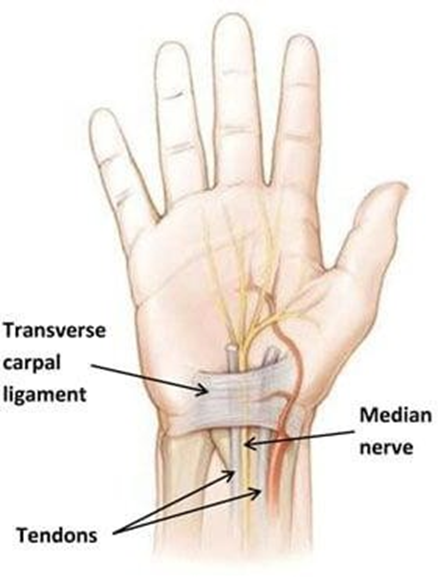The nurse suspects that a client has carpal tunnel syndrome and prepares to conduct the Phalen test. What instructions should the nurse give the client to perform the Phalen test?
Plantarflex the foot
Dorsiflex the foot
Hold both hands back to back while flexing the wrists 90 degrees for 60 seconds
Hyperextend the wrists with the palmar surface of both hands touching, and wait for 60 seconds
The Correct Answer is C
A. Plantarflexion and dorsiflexion refer to movements of the foot and are unrelated to the Phalen test.
B. Hyperextension of the wrists with the palmar surfaces touching is not the correct maneuver for the Phalen test.
C. The Phalen test involves holding both hands back to back while flexing the wrists at a 90- degree angle for about 60 seconds, which may induce symptoms of carpal tunnel syndrome in those affected.
D. Hyperextending the wrists with the palms together doesn’t simulate the stress on the median nerve in the same way as the Phalen test.

Nursing Test Bank
Naxlex Comprehensive Predictor Exams
Related Questions
Correct Answer is A
Explanation
A. Dysmenorrhea refers to painful menstruation, commonly associated with cramping in the lower abdomen.
B. Dysuria is painful or difficult urination, unrelated to menstrual pain.
C. Hematuria is the presence of blood in the urine, not associated with menstrual pain.
D. Dyschezia refers to painful bowel movements, not related to menstrual pain.
Correct Answer is D
Explanation
A. Dysfunction of the motor component of CN X (vagus nerve) and sensory component of CN VII (facial nerve) would present with different symptoms, such as difficulty swallowing and impaired taste sensation, not the observed facial asymmetry and puffing of cheeks.
B. CN XI (accessory nerve) dysfunction primarily affects the sternocleidomastoid and trapezius muscles and wouldn't cause the observed facial asymmetry.
C. Dysfunction of CN IV (trochlear nerve) leads to issues with downward and inward eye movement, not the facial asymmetry described.
D. Dysfunction of the motor component of CN VII (facial nerve) leads to facial asymmetry during expressions and difficulty controlling facial muscles, which matches the observed findings.
Whether you are a student looking to ace your exams or a practicing nurse seeking to enhance your expertise , our nursing education contents will empower you with the confidence and competence to make a difference in the lives of patients and become a respected leader in the healthcare field.
Visit Naxlex, invest in your future and unlock endless possibilities with our unparalleled nursing education contents today
Report Wrong Answer on the Current Question
Do you disagree with the answer? If yes, what is your expected answer? Explain.
Kindly be descriptive with the issue you are facing.
